
Great teams perform superb work and also shape a successful future. They encourage their people to maintain today’s business whilst also developing tomorrow’s business.
This article describes one approach to making this happen. Imagine that you lead a team. You may wish to start by gathering people together and reminding them of the big picture.
Different leaders will do this in different ways. One approach is to remind people of the team’s purpose, principles and picture of success. You can do this by talking them through the following framework.
The Purpose
The purpose of our team – the specific
thing we really want to do – is:
*
The specific reasons why we want to pursue this purpose
– including the benefits for the various stakeholders – are:
*
*
*
The Principles
The principles we want people to follow to achieve this
purpose – together with the reasons for these – are:
*
*
*
The Picture Of Success
The specific results we want to achieve by …
that will be an expression of our purpose are:
*
*
*
The actual things that we want to hear the various stakeholders
saying then that will show we have achieved the purpose are:
*
*
*
The Present Situation
The specific things that we are doing well and have
delivered so far towards achieving the picture of success are:
*
*
*
The Present And
Potential Challenges
The specific things we can improve
and the potential future challenges are:
*
*
*
Imagine that you have given people this big picture. You can then invite them to focus on what they can do regarding both the present and future business.
One approach is to invite people to go into two groups. One group will focus on today’s business, the other on tomorrow’s business.
Different leaders will position these exercises in different ways. One approach is to say something along the following lines. You will, of course, do this in your own way.
Introducing the exercises on today’s
business and tomorrow’s business
Earlier we revisited our team’s purpose, principles and picture of success. We also looked at the positive things we are doing and the potential challenges. Looking ahead, I now want you to focus on two areas.
Today’s Business
I would like one group to focus on how we can continue to do superb work and maintain today’s business. This may include the specific things we can do:
To clarify which customers are in the Green Zone – the customers where things are going well – and how we can continue to do great work with these customers;
To clarify which customers are in the Amber Zone – the customers where there may be warning signs – and how we can do our best to move these into the Green Zone;
To clarify which customers are in the Red Zone – the customers where things are not going well – and how, if we wish, we can go forwards with these customers;
To clarify the specific things we can do to maintain or improve the service we give to our customers – such as making it easy for them to do business with us, simplifying our processes or adding that touch of class;
To clarify what we can do to build on our strengths – both our individual and collective strengths – to get wins for our customers, wins for our company and wins for ourselves as contributors.
Here is the exercise that I would like people to do on this theme. Try to bring the ideas to life by giving real examples. Write the names of the specific customers with whom it would be possible to implement some of the actions.
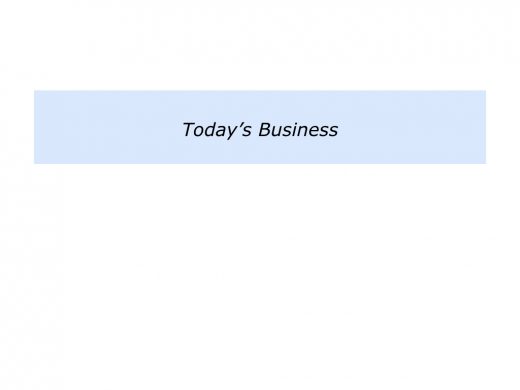
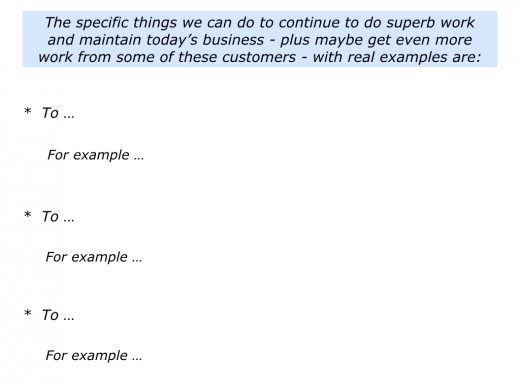
Tomorrow’s Business
I would like another group to focus on how we can develop tomorrow’s business. Many people have ideas about shaping the future but the key is implementation and making a positive impact.
One approach is to work with some of our present customers and clarify their future challenges. It can be particularly useful to focus on our pacesetting customers who are already successful.
We can work with these customers to create products and services that will help them to tackle these challenges. Sometimes this may also involve building prototypes that will help them to achieve future success.
These pacesetting customers are already ahead of the game. They may therefore be exploring challenges that will later affect others in their market.
Today’s customisation is tomorrow’s commodity. So, if we help these customers to achieve success, we may also be creating products that others will need in the future. This can also help us to keep developing as individuals and as a company.
We can work with these customers on specific projects and find solutions to their challenges. This means that: a) We will help them to achieve success: b) We will get paid for the work; c) We will also get funding for developing our future products and services.
This is just one idea for developing tomorrow’s business. You will probably have many more. Bearing this in mind, you may want to consider the specific things we can do:
To clarify the challenges that some of our customers will face in the next one, two and five years;
To clarify how we can build on our strengths to help them to tackle these challenges;
To clarify the specific products and services we can develop to help specific customers – please give the names of these customers – and help them to achieve success;
To work with these customers in ways that mean we can get funding for helping them succeed whilst also developing products and services that help us to achieve future success;
To clarify any other ideas you have for helping us to develop tomorrow’s business.
Here is the exercise that I would like people to tackle. Write the names of the specific customers with whom it would be possible to implement the ideas and make a positive impact.
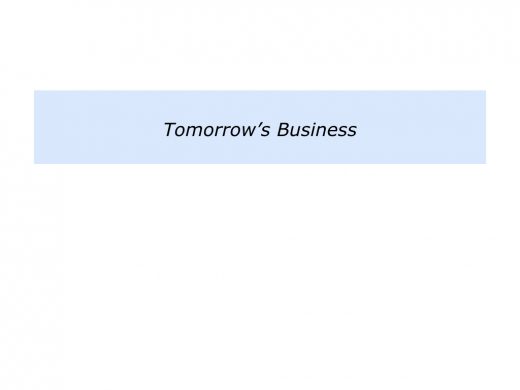
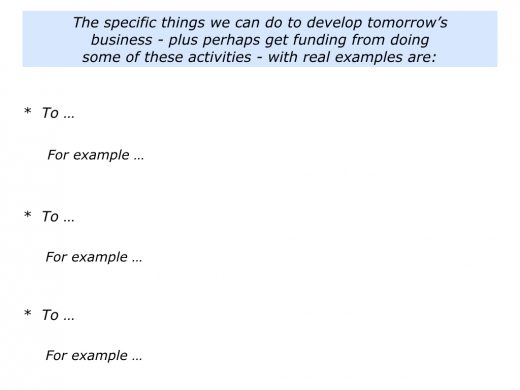
Imagine that people have done these exercises and presented back to the whole team. After discussing the points you can then settle on the team’s action plan.
This will involve clarifying the key strategies the team aims to pursue. You can also appoint mission holders who will be responsible for ensuring each of these strategies are implemented.
Good teams have mission holders who enjoy taking responsibility. They are often eager beavers who like to make lists and implement action plans. They get a kick from getting things done and seeing positive results.
Mission holders are prepared to be accountable, so it is vital to give them the required support. Everybody in the team must know they have the authority to make decisions required to deliver the goods.
Many teams discuss ideas. These plans may not come to fruition, however, unless they appoint mission holders. It is vital to have people who take responsibility for translating the ideas into action.
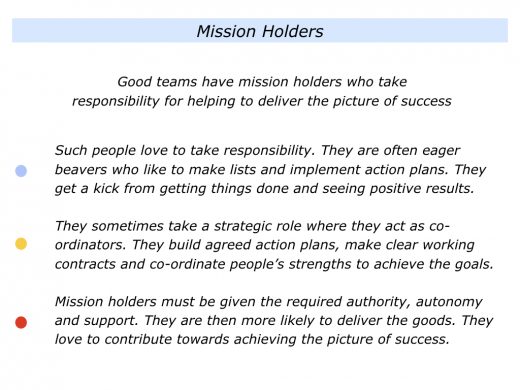
Imagine that you have clarified the key strategies the team will follow and have appointed mission holders. You can then invite people:
To translate each of these strategies into specific action plans and make sure they build in some quick successes;
To schedule regular updates when they will report back about the progress they have made towards delivering the strategies;
To describe any other actions they will take to maintain today’s business and develop tomorrow’s business.
Good leaders educate their people to shape a successful future. One approach is to involve them in developing both today’s business and tomorrow’s business.
You will do this in your own way. If you wish, however, you can invite people to complete the following exercises. They can then do superb work and help the team to achieve ongoing success.
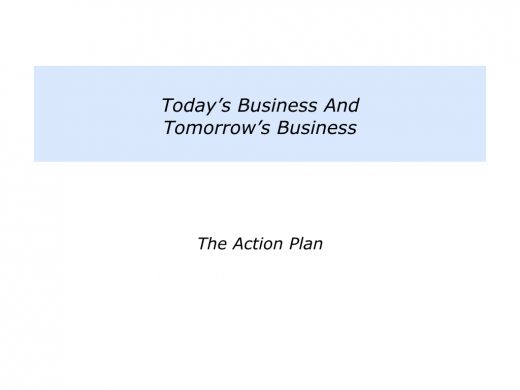
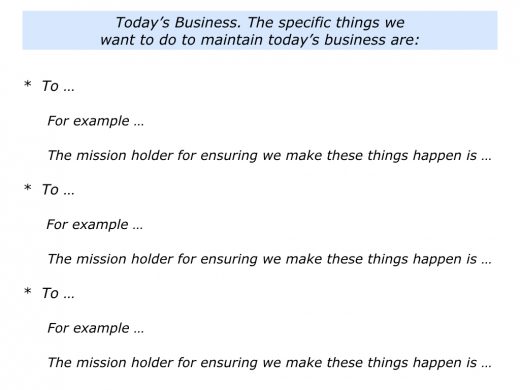
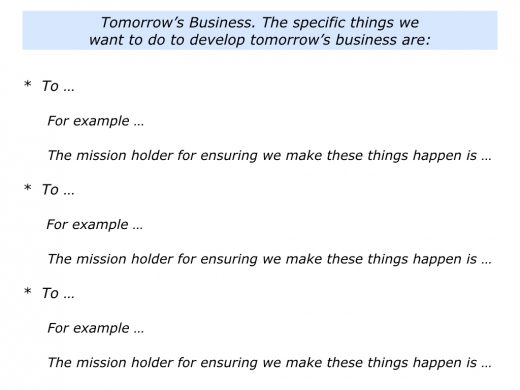






Leave a Reply